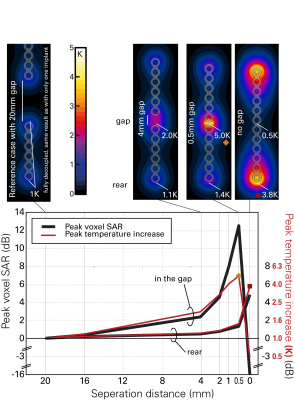4187
Superadditive RF Heating in Gaps between Two Metallic Implants1IT'IS Foundation, Zurich, Switzerland, 2Swiss Federal Institute of Technology (ETH), Zurich, Switzerland
Synopsis
The test method for safety assessment with regard to radiofrequency (RF) heating of small metallic medical implants in MRI is standardized by ASTM. However, the focus lies on individual or electrically connected implant systems whereas, the none-electrically connected combination of multiple adjacent implants has not yet been sufficiently investigated and may lead to considerably altered RF coupling. In this study, we assessed induced heating as a function of the separation distance between two orthopedic metallic implants. Results show that the strong coupling between two short implants may lead to even higher temperature increases than that of a single implant of the combined length.
Introduction
Standardization efforts to limit RF heating around metallic implants1 have led to increased access to magnetic resonance imaging (MRI) scans of these patients. The standardized measurement methods for RF exposure safety1 are applicable to individual implant systems, which may also have multiple components, such as plates and screws2. These scenarios fall under the ASTM category “multiple component and flexible medical devices”, which do not, however, cover adjacent individual implants. Especially orthopedic implants and vascular stents are likely to be placed in proximity to each other. Moreover, such implants may have been placed for different reasons in multiple surgeries.
The aim of this study is to assess the decay rate of RF coupling and subsequent RF heating between two metallic orthopedic implants as a function of their separation distance.
Methods
The commercial simulation platform Sim4Life (ZMT Zurich MedTech AG, Switzerland) was used to investigate two generic electrically short implants (30 mm, Figure 1) exposed in an iso-electric uniform tangential electric (E-) field at 64 MHz, where the half-wavelength is around 200 mm in a gel for which the dielectric and thermal properties correspond to the values defined in the ASTM standard1. A constant isotropic and uniform finite-difference time-domain (FDTD) simulation grid of 0.25 mm was used for the 1 mm thick implants. A subsequent temperature increase simulation based on the field-enhancement was performed to assess the resulting RF heating (6 min). The implants are assumed to be grade-5 titanium with respect to their thermal properties.
The separation distance between the two implants was varied between 0 mm (i.e., electrically connected implants, effectively unified as a single 60 mm implant) and 20 mm (i.e., fully decoupled implants, with resultant in heating identical to that with only one implant present). Results were normalized to the values found for a single 30 mm implant.
Results and Discussion
The peak voxel specific absorption rate (SAR) for a constant voxel edge-length of 0.25 mm is shown in Figure 2, together with the resulting peak temperature increase and temperature distributions. The peak voxel SAR correlates well with the temperature increase, assuming that the thermal situations are similar, i.e., at least 2 mm of gel around the hotspot. As soon as the two implants are moved closer together, the thermal situation changes because of heat-loss through two adjacent metal interfaces, and the correlation is weak. The voxel SAR in the 0.5 mm gap is more than 12 dB higher than for the reference case with a single 30 mm implant. Due to cooling through the titanium on both sides of the gap-hotspot, the temperature increase of 1 – 5 K is only 7 dB higher. However, this is still higher than the peak temperature reached when two 30 mm implants are combined as a single 60 mm implant (3.8 K; 5.8 dB).
We are currently developing an approximation and test method in order to efficiently evaluate the maximum enhancement posed by two non-electrically coupled leads. In addition to the scenario of two implants separated by a small distance, the situation involving damaged stents or broken orthopedic devices, where the implant-fracture could result in a separation of <1 mm is of interest. Implants of smaller widths could further increase the temperature increase in gaps because of the absence of metallic cooling.
Conclusions
To the best of our knowledge, this is the first study that observed potentially safety-critical enhancements of heating in the gap between two adjacent orthopedic metallic implants, which can even exceed the heating from a single implant having the combined length of the two short implants. The potential implications should be investigated with regards to clinical relevance and for other implant geometries, such as metallic stents or broken leads.Acknowledgements
This project has received funding from the EMPIR programme co-financed by the Participating States and from the European Union’s Horizon 2020 research and innovation programme.References
1. ASTM. F2182-11a. Standard Test Method for Measurement of Radio Frequency Induced Heating Near Passive Implants During Magnetic Resonance Imaging. 2011:1–8.
2. Liu Y, Chen J, Shellock FG, Kainz W. Computational and experimental studies of an orthopedic implant: MRI-related heating at 1.5-T/64-MHz and 3-T/128-MHz. J Mag Res Imag 2013;37:491–497.
Figures

